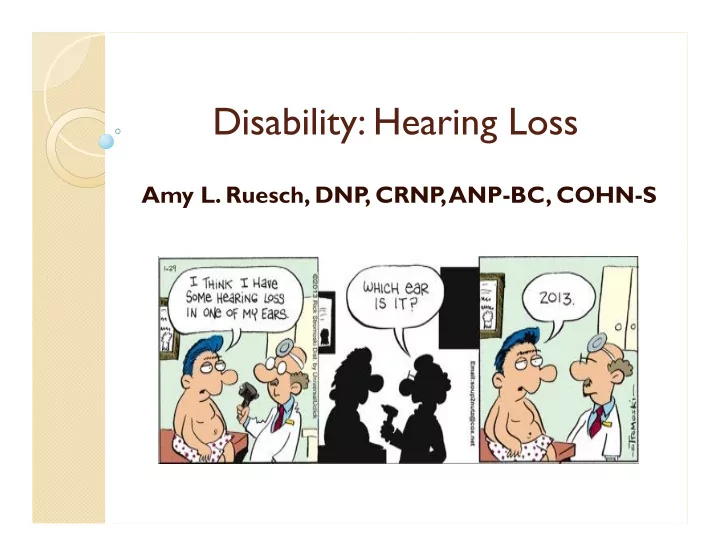

Disability: Hearing Loss Amy L. Ruesch, DNP , CRNP , ANP-BC, COHN-S
Objectives 1. Cite 2 laws pertaining to communication with a person who has a hearing disability 2. Identify 3 barriers to communication 3. List 5 communication strategies to use 4. List 2 communication technologies used to communicate with a person who has a hearing loss or is Deaf.
Introduction 3 rd common chronic health condition in U.S. Often described as an invisible condition Effective communication = safe, quality care Poor communication = negative outcomes Laws Section 504 of the Rehabilitation Act of 1973 American with Disability Act of 1990 Healthcare Regulatory Agency The Joint Commission
What is hearing loss? The deterioration of the ability to perceive or comprehend sounds Can range from mild to profound
What is deafness? An audiological lack of hearing Those individuals who have a severe to profound level of hearing loss before the age of 3 (prelingually) Prefer sign language as their first choice of communication Consider themselves part of the “ D eaf community” with a capital D to emphasize their identity
What is communication? Definition Provider/employer understands and assimilates patient/employee information Patient/employee clearly comprehends messages from provider/employer Communication forms utilized Lip reading Sign language
Lip reading The act or process of determining the intended meaning of a speaker by utilizing all visual cues accompanying speech attempts as lip movements, facial expressions, and bodily gestures, used especially by people with impaired hearing
Challenges with lip reading Yields 30-40% understanding Many sounds look the same and are not entirely visible or easily recognizable Barriers encountered
American Sign Language Visual, gestural, complex language that has its own vocabulary, grammar, and syntax Combination of American Indian and French signs Employs signs made with the hands and other movements, including facial expressions and body postures along with finger spelling of individual alphabet letters known as manual alphabet.
American Sign Language
American Sign Language: Alphabet
Communication Strategies Conduct a communication preference assessment Physical environment conditions Speaker’s behavior Assess comprehension or understanding Allow more time
Communication Aids Needs to be present Medical Sign Language Interpreters Communication technology Telephone amplifiers Teletypewriter (TTY) Telecommunications Device for the Deaf (TTD) Video Relay Service (VRS) or Webcams Video Remote Interpreting – use of Ipad
Teletypewriter
Video Relay Service or Webcams
Teaching Approaches Ask what is his/her preferred learning method Employ visual teaching tools/methods Use sign language interpreters Use videos with printed materials Closed caption included Check for understanding Often learn by seeing/doing
Resources National Association of the Deaf: https://www.nad.org/ ADA.gov Information and Technical Assistance on the American with Disabilities Act: https://www.ada.gov/ Advancing effective communication, cultural competence, and patient- and-family-centered care: A road map for hospitals – Retrieved from http://www.jointcommission.org/roadmap_for hospitals/ ADA business BRIEF: Communicating with people who are deaf or hard of hearing in hospital settings. Retrieved from http://www.ada.gov Hearing Loss Association of America: http://www.hearingloss.org/content/hearing-assistive-technology
Recommend
More recommend